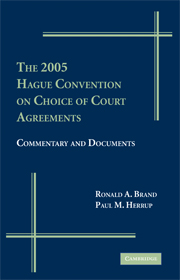Book contents
- Frontmatter
- Contents
- Preface
- PART I A BASIC INTRODUCTION TO THE 2005 HAGUE CHOICE OF COURT CONVENTION
- PART II ARTICLE-BY-ARTICLE COMMENTARY ON THE CONVENTION
- 4 Scope and Definitions (Articles 1–4)
- 5 Jurisdiction (Articles 5–7)
- 6 Recognition and Enforcement (Articles 8–15)
- 7 General Clauses (Articles 16–26)
- 8 Final Clauses (Articles 27–34)
- PART III CHOICE OF COURT IN THE ABSENCE OF A MULTILATERAL CONVENTION
- PART IV LITIGATION AND ARBITRATION CHOICES AFTER THE HAGUE CONVENTION
- Appendix A Explanatory Report by Trevor Hartley & Masato Dogauchi (including the text of the 2005 Hague Convention on Choice of Court Agreements)
- Appendix B Cited Excerpts from the Nygh-Pocar Report
- Index
5 - Jurisdiction (Articles 5–7)
from PART II - ARTICLE-BY-ARTICLE COMMENTARY ON THE CONVENTION
Published online by Cambridge University Press: 26 October 2009
- Frontmatter
- Contents
- Preface
- PART I A BASIC INTRODUCTION TO THE 2005 HAGUE CHOICE OF COURT CONVENTION
- PART II ARTICLE-BY-ARTICLE COMMENTARY ON THE CONVENTION
- 4 Scope and Definitions (Articles 1–4)
- 5 Jurisdiction (Articles 5–7)
- 6 Recognition and Enforcement (Articles 8–15)
- 7 General Clauses (Articles 16–26)
- 8 Final Clauses (Articles 27–34)
- PART III CHOICE OF COURT IN THE ABSENCE OF A MULTILATERAL CONVENTION
- PART IV LITIGATION AND ARBITRATION CHOICES AFTER THE HAGUE CONVENTION
- Appendix A Explanatory Report by Trevor Hartley & Masato Dogauchi (including the text of the 2005 Hague Convention on Choice of Court Agreements)
- Appendix B Cited Excerpts from the Nygh-Pocar Report
- Index
Summary
INTRODUCTION
Chapter II consists of three articles, and contains two of the three pillars of the Convention. Article 5 provides that a court designated in an exclusive choice of court agreement shall have jurisdiction to decide a dispute to which the agreement applies. Article 6 provides that courts in other Contracting States shall not exercise jurisdiction to decide a dispute that has been allocated by such an agreement to a court in another Contracting State. The exceptions to these rules found in Chapter II of the Convention maintain a careful balance between considerations of party autonomy and the interests and abilities of States to structure their legal systems in a manner which reflects their own values.
EXCLUSIVE JURISDICTION OF THE CHOSEN COURT
Article 5(1) sets out the fundamental rule of jurisdiction under the Convention that a court designated in an exclusive choice of court agreement has jurisdiction to decide a dispute to which the agreement applies, unless the agreement is null and void. The effect of Article 5(2) is to require that such jurisdiction be exercised, unless exercise of the jurisdiction runs afoul of the limitations found in Article 5(3).
Article 5 does not apply unless a court determines that it is designated in an exclusive choice of court agreement. The issues of what constitutes an exclusive choice of court agreement and what constitutes a proper designation were addressed in the discussion of Article 3, above.
- Type
- Chapter
- Information
- The 2005 Hague Convention on Choice of Court AgreementsCommentary and Documents, pp. 78 - 97Publisher: Cambridge University PressPrint publication year: 2008

